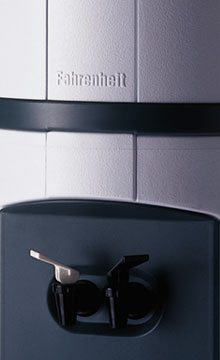Fahrenheit is a temperature scale named after the German-Dutch physicist Daniel Gabriel Fahrenheit (1686–1736), who proposed it in 1724.
In this scale, the freezing point of water is 32 degrees Fahrenheit (written "32 °F"), and the boiling point is 212 degrees, placing the boiling and freezing points of water exactly 180 degrees apart. On the Celsius scale, the freezing and boiling points of water are exactly 100 degrees apart, thus the unit of this scale, a degree Fahrenheit, is ⁄9 of a degree Celsius.
Absolute zero is at −459.67 °F. The Rankine temperature scale was invented to use degrees the same size as Fahrenheit degrees, and so that at 0 °R would be absolute zero. Thus, 0 °R is the same as −459.67 °F.
History
The Fahrenheit scale was the primary temperature standard for climatic, industrial and medical purposes in most English-speaking countries until the 1960s. In the late 1960s and 1970s, the Celsius (formerly Centigrade) scale was phased in by governments as part of the standardizing process of metrication.
Fahrenheit supporters assert its previous popularity was due to Fahrenheit's user-friendliness. The unit of measure, being only ⁄9 the size of the Celsius degree, permits more precise communication of measurements without resorting to fractional degrees. Also, the ambient air temperature in most inhabited regions of the world tends not to go far beyond the range of 0 °F to 100 °F: therefore, the Fahrenheit scale would reflect the perceived ambient temperatures, following 10-degree bands that emerge in the Fahrenheit system. Also, coincidentally, the smallest sensible temperature change averages one Fahrenheit degree; that is, the average person can just detect a temperature difference of a single degree.
But some Celsius supporters argue that their system can be just as natural; for example, they might say that 0–10 °C indicates cold, 10–20 °C mild, 20–30 °C warm and 30–40 °C hot.
In the United States the Fahrenheit system continues to be the accepted standard for non-scientific use. All other countries have adopted Celsius as the primary scale in use. Fahrenheit is sometimes used by older generations in English speaking countries, especially for measurement of higher temperatures.
 The special Unicode °F character
The special Unicode °F characterComparison of temperature scales

 Lefthit
Lefthit
No comments:
Post a Comment